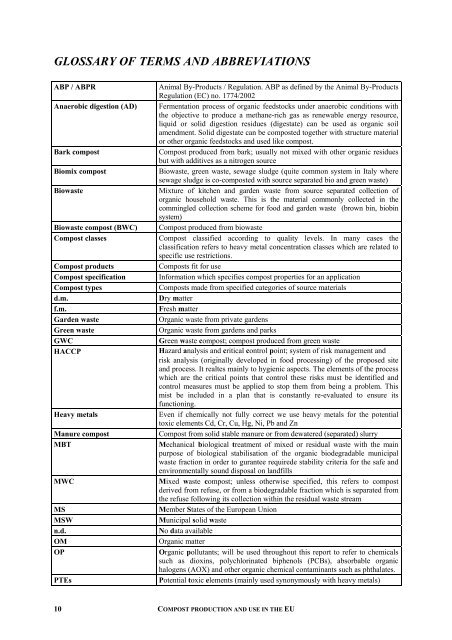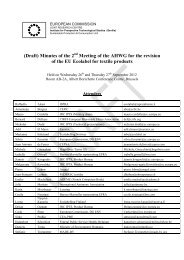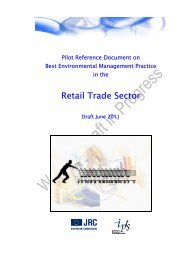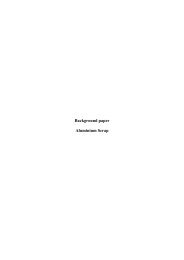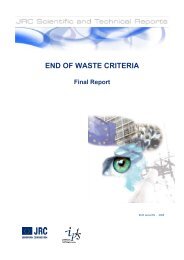final report - JRC IPTS - Sustainable Production and Consumption ...
final report - JRC IPTS - Sustainable Production and Consumption ...
final report - JRC IPTS - Sustainable Production and Consumption ...
You also want an ePaper? Increase the reach of your titles
YUMPU automatically turns print PDFs into web optimized ePapers that Google loves.
GLOSSARY OF TERMS AND ABBREVIATIONS<br />
ABP / ABPR Animal By-Products / Regulation. ABP as defined by the Animal By-Products<br />
Regulation (EC) no. 1774/2002<br />
Anaerobic digestion (AD) Fermentation process of organic feedstocks under anaerobic conditions with<br />
the objective to produce a methane-rich gas as renewable energy resource,<br />
liquid or solid digestion residues (digestate) can be used as organic soil<br />
amendment. Solid digestate can be composted together with structure material<br />
or other organic feedstocks <strong>and</strong> used like compost.<br />
Bark compost Compost produced from bark; usually not mixed with other organic residues<br />
but with additives as a nitrogen source<br />
Biomix compost Biowaste, green waste, sewage sludge (quite common system in Italy where<br />
sewage sludge is co-composted with source separated bio <strong>and</strong> green waste)<br />
Biowaste Mixture of kitchen <strong>and</strong> garden waste from source separated collection of<br />
organic household waste. This is the material commonly collected in the<br />
commingled collection scheme for food <strong>and</strong> garden waste (brown bin, biobin<br />
system)<br />
Biowaste compost (BWC) Compost produced from biowaste<br />
Compost classes Compost classified according to quality levels. In many cases the<br />
classification refers to heavy metal concentration classes which are related to<br />
specific use restrictions.<br />
Compost products Composts fit for use<br />
Compost specification Information which specifies compost properties for an application<br />
Compost types Composts made from specified categories of source materials<br />
d.m. Dry matter<br />
f.m. Fresh matter<br />
Garden waste Organic waste from private gardens<br />
Green waste Organic waste from gardens <strong>and</strong> parks<br />
GWC Green waste compost; compost produced from green waste<br />
HACCP<br />
Hazard analysis <strong>and</strong> critical control point; system of risk management <strong>and</strong><br />
risk analysis (originally developed in food processing) of the proposed site<br />
<strong>and</strong> process. It realtes mainly to hygienic aspects. The elements of the process<br />
which are the critical points that control these risks must be identified <strong>and</strong><br />
control measures must be applied to stop them from being a problem. This<br />
mist be included in a plan that is constantly re-evaluated to ensure its<br />
functioning.<br />
Heavy metals Even if chemically not fully correct we use heavy metals for the potential<br />
toxic elements Cd, Cr, Cu, Hg, Ni, Pb <strong>and</strong> Zn<br />
Manure compost Compost from solid stable manure or from dewatered (separated) slurry<br />
MBT Mechanical biological treatment of mixed or residual waste with the main<br />
purpose of biological stabilisation of the organic biodegradable municipal<br />
waste fraction in order to gurantee requirede stability criteria for the safe <strong>and</strong><br />
environmentally sound disposal on l<strong>and</strong>fills<br />
MWC Mixed waste compost; unless otherwise specified, this refers to compost<br />
derived from refuse, or from a biodegradable fraction which is separated from<br />
the refuse following its collection within the residual waste stream<br />
MS Member States of the European Union<br />
MSW Municipal solid waste<br />
n.d. No data available<br />
OM Organic matter<br />
OP Organic pollutants; will be used throughout this <strong>report</strong> to refer to chemicals<br />
such as dioxins, polychlorinated biphenols (PCBs), absorbable organic<br />
halogens (AOX) <strong>and</strong> other organic chemical contaminants such as phthalates.<br />
PTEs Potential toxic elements (mainly used synonymously with heavy metals)<br />
10<br />
COMPOST PRODUCTION AND USE IN THE EU


